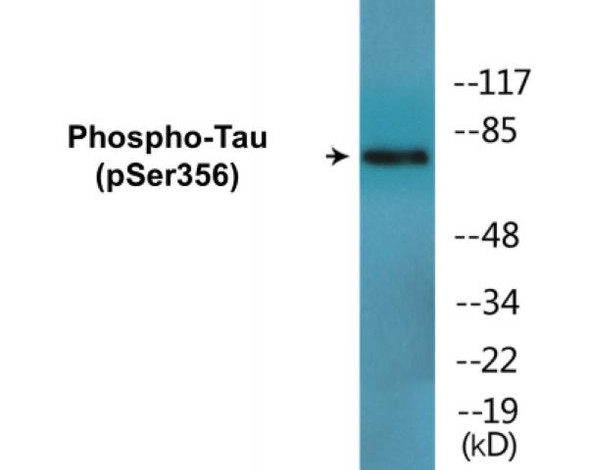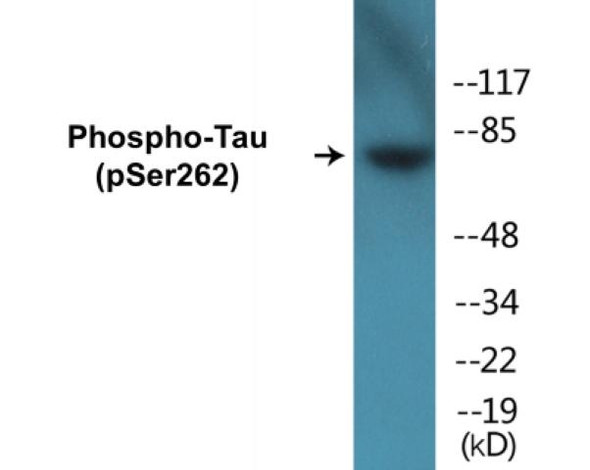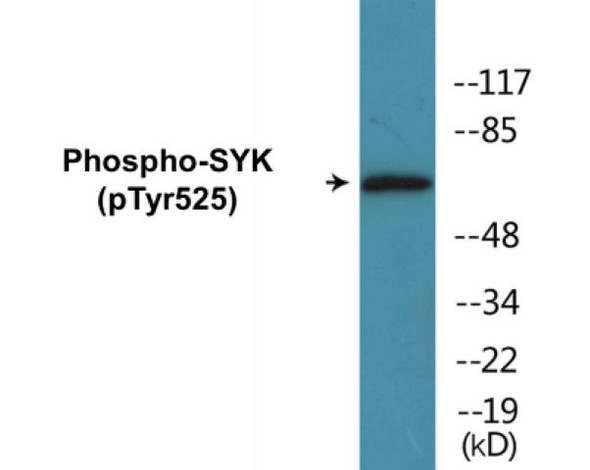Description
Tau (Phospho-Ser214) Cell-Based ELISA Kit
The Tau (Phospho-Ser214) Cell-Based ELISA Kit is a convenient, lysate- free, high throughput and sensitive assay kit that can monitor Tau phosphorylation and expression profile in cells. The kit can be used for measuring the relative amounts of phosphorylated Tau in cultured cells as well as screening for the effects that various treatments, inhibitors (ie. siRNA or chemicals), or activators have on Tau phosphorylation.
How does our Tau (Phospho-Ser214) Fluorometric Cell-Based ELISA Kit work?
Qualitative determination of Tau (Phospho-Ser214) concentration is achieved by an indirect ELISA format. In essence, Tau (Phospho-Ser214) is captured by Tau (Phospho-Ser214)-specific primary (1°) antibodies while Dye 1-conjugated and Dye 2-conjugated secondary (2°) antibodies bind the Fc region of the 1° antibody. Through this binding, the dye conjugated to the 2° antibody can emit light at a certain wavelength given proper excitation, hence allowing for a fluorometric detection method. Due to the qualitative nature of the Cell-Based ELISA, multiple normalization methods are needed:
| 1. | A monoclonal antibody specific for human GAPDH is included to serve as an internal positive control in normalizing the target RFU values. |
| 2. | An antibody against the nonphosphorylated counterpart of Tau (Phospho-Ser214) is also provided for normalization purposes. The RFU values obtained for non-phosphorylated Tau can be used to normalize the RFU value for phosphorylated Tau. |
Tau (Phospho-Ser214) Fluorometric Cell-Based ELISA Kit -Information
| Product Name: | Tau (Phospho-Ser214)Fluorometric Cell-Based ELISA Kit |
| Product Code/SKU: | FBCAB00082 |
| Description: | The Tau (Phospho-Ser214) Fluorometric Cell-Based Phospho ELISA Kit is a convenient, lysate-free, high throughput and sensitive assay kit that can monitor Tau (Phospho-Ser214) protein phosphorylation and expression profile in cells. The kit can be used for measuring the relative amounts of phosphorylated Tau (Phospho-Ser214) in cultured cells as well as screening for the effects that various treatments, inhibitors (ie. siRNA or chemicals, or activators have on MAPT phosphorylation. |
| Dynamic Range: | > 5000 Cells |
| Detection Method: | Fluorometric |
| Storage/Stability: | 4°C/6 Months |
| Reactivity: | Human, Mouse, Rat |
| Assay Type: | Cell-Based ELISA |
| Database Links: | Gene ID: 4137, UniProt ID: P10636, OMIM #: 157140/172700/260540/600274/601104/607485, Unigene #: Hs.101174 |
| Format: | Two 96-Well Plates |
| NCBI Gene Symbol: | MAPT |
| Sub Type: | Phospho |
| Target Name: | Phospho-Tau (Ser214) |
Kit Principle
Figure: Schematic representation of Assay Genie Cell-Based Fluorometric ELISA principle
Kit components | Quantity |
| 96-Well Black Cell CultureClear-Bottom Microplate | 2 plates |
| 10X TBS | 24 ml |
| Quenching Buffer | 24 ml |
| Blocking Buffer | 50 ml |
| 15X Wash Buffer | 50 ml |
| Primary Antibody Diluent | 12 ml |
| 100x Anti-Phospho Target Antibody | 60 µl |
| 100x Anti-Target Antibody | 60 µl |
| Anti-GAPDH Antibody | 110 µl |
| Dye-1 Conjugated Anti-Rabbit IgG Antibody | 6 ml |
| Dye-2 Conjugated Anti-Mouse IgG Antibody | 6 ml |
| Adhesive Plate Seals | 2 seals |
Additional equipment and materials required
The following materials and/or equipment are NOT provided in this kit but are necessary to successfully conduct the experiment:
- Fluorescent plate reader with two channels at Ex/Em: 651/667 and 495/521
- Micropipettes capable of measuring volumes from 1 µl to 1 ml
- Deionized or sterile water (ddH2O)
- 37% formaldehyde (Sigma Cat# F-8775) or formaldehyde from other sources
- Squirt bottle, manifold dispenser, multichannel pipette reservoir or automated microplate washer
- Graph paper or computer software capable of generating or displaying logarithmic functions
- Absorbent papers or vacuum aspirator
- Test tubes or microfuge tubes capable of storing ≥1 ml
- Poly-L-Lysine (Sigma Cat# P4832 for suspension cells)
- Orbital shaker (optional)
Kit Protocol
This is a summarized version of the kit protocol. Please view the technical manual of this kit for information on sample preparation, reagent preparation and plate lay out.
| 1. | Seed 200 µl of desired cell concentration in culture medium into each well of the 96-well plates. For suspension cells and loosely attached cells, coat the plates with 100 µl of 10 µg/ml Poly-L-Lysine (not included) to each well of a 96-well plate for 30 minutes at 37°C prior to adding cells. |
| 2. | Incubate the cells for overnight at 37°C, 5% CO2. |
| 3. | Treat the cells as desired. |
| 4. | Remove the cell culture medium and rinse with 200 µl of 1x TBS, twice. |
| 5. | Fix the cells by incubating with 100 µl of Fixing Solution for 20 minutes at room temperature. The 4% formaldehyde is used for adherent cells and 8% formaldehyde is used for suspension cells and loosely attached cells. |
| 6. | Remove the Fixing Solution and wash the plate 3 times with 200 µl 1x Wash Buffer for 3 minutes. The plate can be stored at 4°C for a week. |
| 7. | Add 100 µl of Quenching Buffer and incubate for 20 minutes at room temperature. |
| 8. | Wash the plate 3 times with 1x Wash Buffer for 3 minutes each time. |
| 9. | Dispense 200 µl of Blocking Buffer and incubate for 1 hour at room temperature. |
| 10. | Wash 3 times with 200 µl of 1x Wash Buffer for 3 minutes each time. |
| 11. | Add 50 µl of Primary Antibody Mixture P to corresponding wells for Tau (Phospho-Ser214) detection. Add 50 µl of Primary Antibody Mixture NP to the corresponding wells for total Tau detection. Cover the plate with parafilm and incubate for 16 hours (overnight) at 4°C. If the target expression is known to be high, incubate for 2 hours at room temperature. |
| 12. | Wash 3 times with 200 µl of 1x Wash Buffer for 3 minutes each time. |
| 13. | Add 50 ul of Secondary Antibody Mixture to corresponding wells and incubate for 1.5 hours at room temperature in the dark. |
| 14. | Wash 3 times with 200 µl of 1x Wash Buffer for 3 minutes each time. |
| 15. | Read the plate(s) at Ex/Em: 651/667 (Dye 1) and 495/521 (Dye 2). Shield plates from direct light exposure. |
| 16. | Wash 3 times with 200 µl of 1x Wash Buffer for 5 minutes each time. |
Tau (Phospho-Ser214) - Protein Information
| UniProt Protein Function: | Tau: a microtubule-associated protein that regulates microtubule assembly and stability. Apparently involved in the establishment and maintenance of neuronal polarity. Mutations can result in several neurodegenerative disorders such as Alzheimer's disease, Pick's disease, frontotemporal dementia, cortico-basal degeneration and progressive supranuclear palsy. The C-terminus binds axonal microtubules while the N-terminus binds neural plasma membrane components, suggesting that tau functions as a linker. Axonal polarity is predetermined by tau localization (in the neuronal cell) in the domain of the cell body defined by the centrosome. Nine differentially spliced isoforms have been described. The short isoforms allow plasticity of the cytoskeleton, whereas the longer isoforms may preferentially play a role in its stabilization. |
| UniProt Protein Details: | Protein type:Cytoskeletal Chromosomal Location of Human Ortholog: 17q21.1 Cellular Component: microtubule; microtubule associated complex; growth cone; axon; tubulin complex; plasma membrane; axoneme; cytosol Molecular Function:protein binding; enzyme binding; structural constituent of cytoskeleton; microtubule binding; apolipoprotein binding; protein kinase binding; SH3 domain binding Biological Process: axon extension; apoptosis; positive regulation of microtubule polymerization; positive regulation of axon extension; axon cargo transport; neuron migration; microtubule cytoskeleton organization and biogenesis; adult walking behavior; regulation of microtubule polymerization; mitochondrion transport along microtubule; negative regulation of intracellular transport; generation of neurons; regulation of autophagy; cell structure disassembly during apoptosis Disease: Supranuclear Palsy, Progressive, 1; Pick Disease Of Brain; Frontotemporal Dementia; Parkinson-dementia Syndrome; Parkinson Disease, Late-onset; Frontotemporal Lobar Degeneration With Tdp43 Inclusions, Grn-related |
| NCBI Summary: | This gene encodes the microtubule-associated protein tau (MAPT) whose transcript undergoes complex, regulated alternative splicing, giving rise to several mRNA species. MAPT transcripts are differentially expressed in the nervous system, depending on stage of neuronal maturation and neuron type. MAPT gene mutations have been associated with several neurodegenerative disorders such as Alzheimer's disease, Pick's disease, frontotemporal dementia, cortico-basal degeneration and progressive supranuclear palsy. [provided by RefSeq, Jul 2008] |
| UniProt Code: | P10636 |
| NCBI GenInfo Identifier: | 6754638 |
| NCBI Gene ID: | 4137 |
| NCBI Accession: | NP_005901 |
| UniProt Related Accession: | P10636 |
| Molecular Weight: | 46kDa |
| NCBI Full Name: | microtubule-associated protein tau isoform 2 |
| NCBI Synonym Full Names: | microtubule associated protein tau |
| NCBI Official Symbol: | MAPT |
| NCBI Official Synonym Symbols: | TAU; MSTD; PPND; DDPAC; MAPTL; MTBT1; MTBT2; FTDP-17; PPP1R103 |
| NCBI Protein Information: | microtubule-associated protein tau |
| UniProt Protein Name: | Microtubule-associated protein tau |
| UniProt Synonym Protein Names: | Neurofibrillary tangle protein; Paired helical filament-tau |
| Protein Family: | Tautomerase |
| UniProt Gene Name: | MAPT |
| UniProt Entry Name: | TAU_HUMAN |







